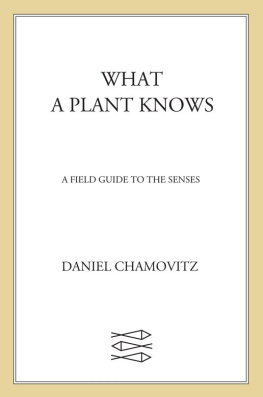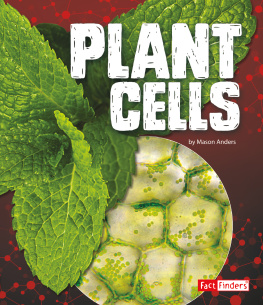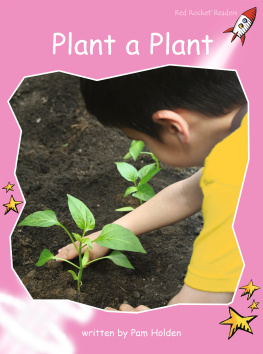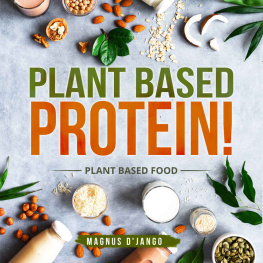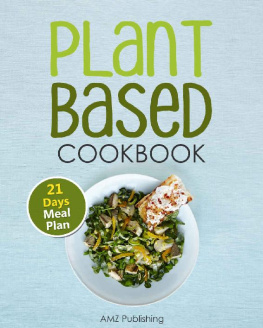Daniel Chamovitz - What a Plant Knows
Here you can read online Daniel Chamovitz - What a Plant Knows full text of the book (entire story) in english for free. Download pdf and epub, get meaning, cover and reviews about this ebook. publisher: Farrar, Straus and Giroux, genre: Religion. Description of the work, (preface) as well as reviews are available. Best literature library LitArk.com created for fans of good reading and offers a wide selection of genres:
Romance novel
Science fiction
Adventure
Detective
Science
History
Home and family
Prose
Art
Politics
Computer
Non-fiction
Religion
Business
Children
Humor
Choose a favorite category and find really read worthwhile books. Enjoy immersion in the world of imagination, feel the emotions of the characters or learn something new for yourself, make an fascinating discovery.

- Book:What a Plant Knows
- Author:
- Publisher:Farrar, Straus and Giroux
- Genre:
- Rating:5 / 5
- Favourites:Add to favourites
- Your mark:
- 100
- 1
- 2
- 3
- 4
- 5
What a Plant Knows: summary, description and annotation
We offer to read an annotation, description, summary or preface (depends on what the author of the book "What a Plant Knows" wrote himself). If you haven't found the necessary information about the book — write in the comments, we will try to find it.
What a Plant Knows — read online for free the complete book (whole text) full work
Below is the text of the book, divided by pages. System saving the place of the last page read, allows you to conveniently read the book "What a Plant Knows" online for free, without having to search again every time where you left off. Put a bookmark, and you can go to the page where you finished reading at any time.
Font size:
Interval:
Bookmark:
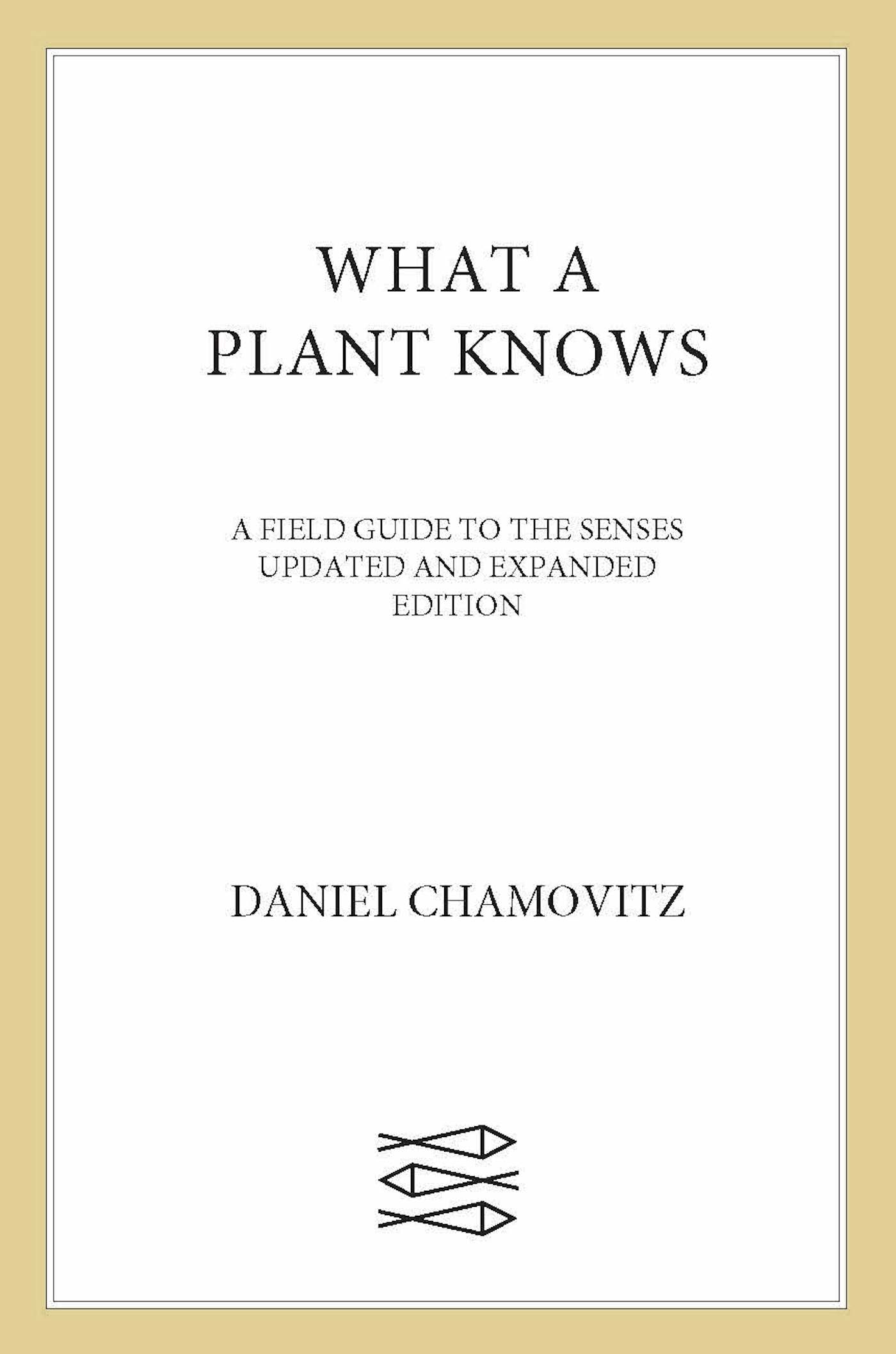

The author and publisher have provided this e-book to you for your personal use only. You may not make this e-book publicly available in any way. Copyright infringement is against the law. If you believe the copy of this e-book you are reading infringes on the authors copyright, please notify the publisher at: us.macmillanusa.com/piracy.
For Shira, Eytan, Noam, and Shani
In the five years since the publication of the first edition of What a Plant Knows, weve seen a blossoming of interest in plant senses. The rate of scientific discovery in plant biology is so fast that this new edition contains groundbreaking information that completely contradicts conclusions made in the first. Both the scientific community and the popular press have moved well beyond the pseudoscience that characterized so much of the early interest in plant senses that established plant scientists railed against. And in an age of growing national isolationism, the global interest in how plants respond to their environment is reassuring. The popularity of What a Plant Knows in Beijing and in Munich, in San Francisco and in Seoul, attests to a universal desire to comprehend our green neighbors.
And why shouldnt the interest be universal? After all, we are utterly dependent on plants. We wake up in our house made of wood from the forests of Maine, pour a cup of coffee brewed from coffee beans grown in Brazil, throw on a T-shirt made of Egyptian cotton, print out a report on paper made from eucalyptus trees grown in Tasmania, and drive our kid to school in our car fueled by gasoline derived from cycads that died millions of years ago and with tires made of rubber that was grown in Africa. Chemicals extracted from plants reduce fever (think of aspirin) and treat cancer (Taxol). Wheat sparked the end of one age and the dawn of another, and the humble potato led to mass migrations. And plants continue to inspire and amaze us: the mighty sequoias are the largest singular independent organism on Earth; algae are some of the smallest; and roses definitely make anyone smile.
My interest in the parallels between plant and human senses got its start when I was a young postdoctoral fellow at Yale University in the 1990s. I was interested in studying a biological process specific to plants and not connected to human biology (probably as a response to the six other doctors in my family, all of whom are physicians). Hence I was drawn to the question of how plants use light to regulate their development. In my research, I discovered a unique group of genes necessary for a plant to determine if its in the light or in the dark. Much to my surprise and against all of my plans, I later discovered that this same group of genes is also part of the human DNA. This led to the obvious question as to what these seemingly plant-specific genes do in people. Many years later and after much research, we now know that these genes not only are conserved between plants and animals but also regulate (among other developmental processes) responses to light in both!
This led me to realize that the genetic difference between plants and animals is not as significant as I had once believed. I began to question the parallels between plant and human biology even as my own research evolved from studying plant responses to light to leukemia in fruit flies. What I discovered was that while theres no plant that knows how to say Feed me, Seymour! there are many plants that know quite a bit.
Indeed, we tend not to pay much attention to the immensely sophisticated sensory machinery in the flowers and trees that can be found right in our own backyards. While most animals can choose their environments, seek shelter in a storm, search for food and a mate, or migrate with the changing seasons, plants must be able to withstand and adapt to constantly changing weather, encroaching neighbors, and invading pests, without being able to move to a better environment. Because of this, plants have evolved complex sensory and regulatory systems that allow them to modulate their growth in response to ever-changing conditions. An elm tree has to know if its neighbor is shading it from the sun so that it can find its own way to grow toward the light thats available. A head of lettuce has to know if there are ravenous aphids about to eat it up so that it can protect itself by making poisonous chemicals to kill the pests. A Douglas fir tree has to know if whipping winds are shaking its branches so that it can grow a stronger trunk. Cherry trees have to know when to flower.
On a genetic level, plants are more complex than many animals, and some of the most important discoveries in all of biology came from research carried out on plants. Robert Hooke first discovered cells in 1665 while studying cork in the early microscope he built. In the nineteenth century, Gregor Mendel worked out the principles of modern genetics using pea plants, and in the mid-twentieth century Barbara McClintock used Indian corn to show that genes can transpose, or jump. We now know that these jumping genes are a characteristic of all DNA and are intimately connected to cancer in humans. And while we recognize that Darwin was a founding father of modern evolutionary theory, some of his most important findings were in plant biology specifically, and well see quite a few of these in the pages of this book.
Clearly, my use of the word know is unorthodox. Plants dont have a central nervous system; a plant doesnt have a brain that coordinates information for its entire body. Yet different parts of a plant are intimately connected, and information regarding light, chemicals in the air, and temperature is constantly exchanged between roots and leaves, flowers and stems, to yield a plant that is optimized for its environment. We cant equate human behavior to the ways in which plants function in their worlds, but I ask that you humor me while I use terminology throughout the book that is usually reserved for human experience. When I explore what a plant sees or what it smells, I am not claiming that plants have eyes or noses (or a brain that colors all sensory input with emotion). But I believe this terminology will help challenge us to think in new ways about sight, smell, what a plant is, and ultimately what we are.
My book is not The Secret Life of Plants; if youre looking for an argument that plants are just like us, you wont find it here. As the renowned plant physiologist Arthur Galston pointed out back in 1974 during the height of interest in this extremely popular but scientifically anemic book, we must be wary of bizarre claims presented without adequate supporting evidence. Worse than leading the unwary reader astray, The Secret Life of Plants led to scientific fallout that stymied important research on plant behavior as scientists became wary of any studies that hinted at parallels between animal senses and plant senses.
In the more than four decades since The Secret Life of Plants caused a great media stir, the depth at which scientists understand plant biology has increased immensely. In What a Plant Knows, I will explore the latest research in plant biology and argue that plants do indeed have senses. By no means is this book an exhaustive and complete review of what modern science has to say about plant senses; that would necessitate a textbook inaccessible to all but the most dedicated readers. Instead, in each chapter I highlight a human sense and compare what the sense is for people and what it is for plants. I describe how the sensory information is perceived, how it is processed, what the ecological implications of the sense are for a plant. And in each chapter Ill present both a historical perspective and a modern look at the topic.
Font size:
Interval:
Bookmark:
Similar books «What a Plant Knows»
Look at similar books to What a Plant Knows. We have selected literature similar in name and meaning in the hope of providing readers with more options to find new, interesting, not yet read works.
Discussion, reviews of the book What a Plant Knows and just readers' own opinions. Leave your comments, write what you think about the work, its meaning or the main characters. Specify what exactly you liked and what you didn't like, and why you think so.

